
I would like to take some time and talk about Robert McKimson right now. First off, I'd like to definitely state that yes he was indeed a great animator. He didn't need that car accident to rattle his optic nerve and give him that tremendous ability but it certainly helped. However, this post will deal with Robert McKimson as a director. Yes, there are people out there who feel that Mr. McKimson was a less than ideal director. Leonard Maltin has been known to ramble on for long periods of time about his feelings of Bob's filmography. Inversely, there are others who feel that McKimson's work is woefully under-rated and that he should be revered along-side the other greats. I am one of those people. Actually, not only is his directorial work fantastic, I've noticed an auteur pattern as well. For those of you un familiar with the Auteur Theory, follow the link to a Wickipedia entry on the subject here. Read all that before you read this blogpost any further or else you will get lost and confused.
To everyone else: let's begin!
From viewings (and many repeated viewings) of McKimson's toons, I have discovered two binary opposites that are integrated into all of them (the ones I've seen anyway). They are:
nervy character / high authority
defiance / "cronie"-ism
I'd love to know exactly how much those elements came from his own life and what he observed. Unfortunately, not enough is written about Robert McKimson. Hell, this blogpost alone probably raised the number of McKimson text by about 20% or so. From what I've read on him, the defiance element of his cartoons could have come from how meek he actually was in real life. Not only that, when his colleagues Chuck Jones and Friz Freleng got any flack from producer Eddie Selzer they defied him right to his face. McKimson, on the other hand would simply cave in to Eddie. This is ecatly what happened when Selzer told McKimson to get rid of the Tazmanian Devil. If it wasn't for Jack Warner himself demanding the character's revival, we wouldn't even have the Tazmanian Devil around today. If anyone out there who knows something about him as a person or even knew him personally, any input about him posted here in the comments section would be greatly appreciated. For now though, I'll point out just where I've seen those binary opposites in his cartoons.
Upon reading the first one, I'm sure many people would say, "but don't all the Bugs Bunny cartoons deal with defying authority no matter who was directing?" Maybe so, but I've noticed that McKimson seemed to take it up a notch or two. Many of the characters who defied authority in his cartoons would give an uneasy "ARE YOU NUTS??!!" feeling to the audience.
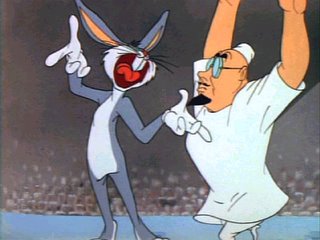 Take for instance Rebel Rabbit (c. 1949). Bugs is so mad at the Game Commissioner for making the rabbit bounty a measily 2 cents that he commits terrorist acts all over America. Not even Bob Clampett's Bugs would do that. Another good example is Gorilla My Dreams (c. 1948). After Bugs is adopted by a childless family of gorillas, papa gorilla (with a W.C. Fields child-hating complex) takes Bugs for a "walk". While alone in the jungle, the gorilla displays a brute strength capable of much destruction. However, Bugs is unimpressed by this and even taunts the beast further by hitiing him with a shovel. I remeber reading somewhere that McKimson's philosophy about Bugs' character is "He's the kind of guy who would walk up to a lion, hear that mighty roar, and then slap him." McKimson certainly put that philosophy to the test with his first Bugs cartoon Acrobatty Bunny (c. 1946). Bugs deals with a circus lion in that very fashion.
Take for instance Rebel Rabbit (c. 1949). Bugs is so mad at the Game Commissioner for making the rabbit bounty a measily 2 cents that he commits terrorist acts all over America. Not even Bob Clampett's Bugs would do that. Another good example is Gorilla My Dreams (c. 1948). After Bugs is adopted by a childless family of gorillas, papa gorilla (with a W.C. Fields child-hating complex) takes Bugs for a "walk". While alone in the jungle, the gorilla displays a brute strength capable of much destruction. However, Bugs is unimpressed by this and even taunts the beast further by hitiing him with a shovel. I remeber reading somewhere that McKimson's philosophy about Bugs' character is "He's the kind of guy who would walk up to a lion, hear that mighty roar, and then slap him." McKimson certainly put that philosophy to the test with his first Bugs cartoon Acrobatty Bunny (c. 1946). Bugs deals with a circus lion in that very fashion. Of course, the most pure example of Bugs' anti-authoritarian stance is his Tazmanian Devil films. Notice how 3 cartoons Devil May Hare (c. 1954), Bedevilled Rabbit (c. 1957), and Dr. Devil and Mr. Hare (c. 1964) all start off with forest animals running for cover as the Tazmanian Devil approaches. This establishes him as King of the Forest for the most part. And even in Bill of Hare (c. 1962), even though Taz starts off in a crate on a boat, the Australian sea captain tells his shipmates to be careful unloading him onto the dock. The reverence in the captain's voice also gives the Tazmanian Devil this authority. All this makes the situation seem more deadly as he approaches Bugs. And yet, Bugs takes care of Taz as he had with the lion and the gorilla in the previous cartoons I mentioned. (Yes, the Tazmanian Devil also appeared with Daffy in Ducking the Devil (c. 1957) except there Daffy is made a coward and immediately starts running. Although, Daffy does confront the Devil when he finds out that music soothes his temper or when Taz-Boy tries to take his money).
Of course, the most pure example of Bugs' anti-authoritarian stance is his Tazmanian Devil films. Notice how 3 cartoons Devil May Hare (c. 1954), Bedevilled Rabbit (c. 1957), and Dr. Devil and Mr. Hare (c. 1964) all start off with forest animals running for cover as the Tazmanian Devil approaches. This establishes him as King of the Forest for the most part. And even in Bill of Hare (c. 1962), even though Taz starts off in a crate on a boat, the Australian sea captain tells his shipmates to be careful unloading him onto the dock. The reverence in the captain's voice also gives the Tazmanian Devil this authority. All this makes the situation seem more deadly as he approaches Bugs. And yet, Bugs takes care of Taz as he had with the lion and the gorilla in the previous cartoons I mentioned. (Yes, the Tazmanian Devil also appeared with Daffy in Ducking the Devil (c. 1957) except there Daffy is made a coward and immediately starts running. Although, Daffy does confront the Devil when he finds out that music soothes his temper or when Taz-Boy tries to take his money).But it wasn't just Bugs who defied authority in McKimson's toons. A delightful cartoon called The Unexpected Pest (c. 1956) deals with a poor mouse putting up with Sylvester's self-appointed authority (though he has to answer to a higher authority that being the owners of the house). Sylvester overhears the homeowners talking about getting rid of him since there are no more mice for him to catch. So, Sylvester makes a secret deal with a mouse he finds outside. As long as the mouse runs into the room and scares the wife everyonce in a while and then let's Sylvester beat on him, he won't get eaten. At first the mouse is a slave to this arrangement because he doesn't want to die. But, later on the mouse does some thinking of his own. In his own words, "it seems that you need me to keep your happy home which now makes me boss around here." From this point on, it is Sylvester at the mercy of both the mouse and the homeowners. In The Honey-Mousers (c. 1956), after Ralph and Ed have had no end of trouble trying to evade a cat in the kitchen, Alice simply walks right up to that feline, pulls off a whisker and yells, "BEAT IT!!"
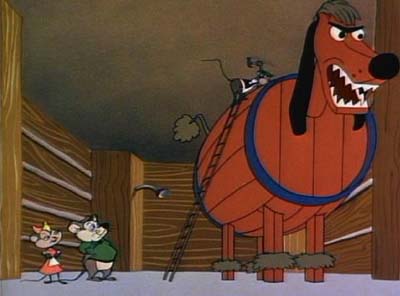 Surprisingly, the cat retreats. Also, check out two of Speedy's drunk friends Pablo and Fernando in Tobasco Road (c. 1957). While walking home drunk through a dark alley they come across a huge cat. Instead of running away like they should, they actually pick a drunken fight with him. Without Speedy's help though, they surely would have been eaten.
Surprisingly, the cat retreats. Also, check out two of Speedy's drunk friends Pablo and Fernando in Tobasco Road (c. 1957). While walking home drunk through a dark alley they come across a huge cat. Instead of running away like they should, they actually pick a drunken fight with him. Without Speedy's help though, they surely would have been eaten.And, of course, this element is all too clear in the Foghorn Leghorn series, ESPECIALLY the ones where Henery Hawk is present. Initially, it's clever rearrangement of the predator/prey set-up found in many WB toons.
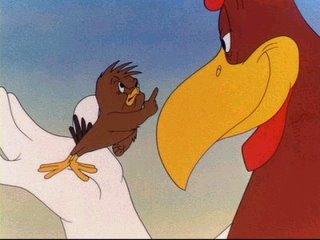
Technically Henery is the predator and Foghorn Leghorn is the prey. But, since Foghorn is so boisterous and Henery is so naive, that relationship becomes moot. Essentially, the whole thing turns into a young infant with "more nerve than a bum tooth" at the mercy of an out-spoken rooster who rules the barnyard (at the expense of that guard dog even). This sort of relationship is there no matter who else approaches Foghorn's authority whether is Egghead Jr. (first seen in Little Boy Boo (c. 1954)), Miss Prissy (first encountering Foggy in Lovelorn Leghorn (c. 1951)), that lint-pickin' weasel (first seen in Plop Goes the Weasel (c. 1953)) or any other one shot characters like the fox (in Fox Terror (c. 1957)), Banty the beatnik (in Banty Raids (c. 1963)) or Kid Banty (in Sock a Doodle Doo (c. 1952)). And, of course, this element is present in Mcimson's creation Speedy Gonzales. His first cartoon Cat-Tails For Two (c. 1953) has Speedy laughing as he deals with two cats that are caricatures of Stienbeck's Of Mice and Men characters.
Interestingly, in many of McKimson's toons, the authority figure to be defied is the father. This is most obvious in the cartoons where he gave Sylvester a son, namely Sylvester Jr. But there are some other toons that deal with this as well such as Sleepy Time Possum (c. 1951), Gorilla My Dreams (c. 1948), and Strife With Father (c. 1950). And then there's Henery Hawk's relationship with his father. In Walky Talky Hawky (c. 1946) the toon starts off by portraying Henery's father as a mellodramatic goof who reads Looney Tunes comics (while Henery reads the more risque Esquire magazine).
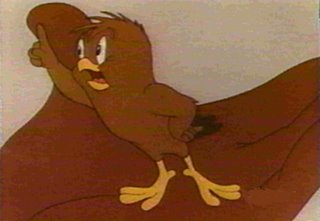 In The Foghorn Leghorn (c. 1948), Henery actually has an arguement with his father about hunting chickens. When his father puts his foot down saying "You're NOT going and that's a that.", Henery defies his father and goes along anyway. There was even a father/son relationship between Foghorn Leghorn and Henery in Strangles Eggs (c. 1961), which Foggy had previously gone through with Egghead Jr. Compare that with the ralationship between Henery and his dad in You Were Never Duckier (c. 1948). In that, Chuck Jones gives the two a very loving and fuctional relationship. (By the way, Chuck Jones as well as some other Looney Tunes directors are also auteurs. But that's a subject for a whoooooole other post.)
In The Foghorn Leghorn (c. 1948), Henery actually has an arguement with his father about hunting chickens. When his father puts his foot down saying "You're NOT going and that's a that.", Henery defies his father and goes along anyway. There was even a father/son relationship between Foghorn Leghorn and Henery in Strangles Eggs (c. 1961), which Foggy had previously gone through with Egghead Jr. Compare that with the ralationship between Henery and his dad in You Were Never Duckier (c. 1948). In that, Chuck Jones gives the two a very loving and fuctional relationship. (By the way, Chuck Jones as well as some other Looney Tunes directors are also auteurs. But that's a subject for a whoooooole other post.)From this evidence, I'm guessing that Bob McKimson may have had an estranged relationship with his own father. Unfortunately, I only have the evidence of the toons to support that. Anyone who can shed some light on this apsect of his life, please comment here.

Okay, I've typed quite a bit about the defiance of authority aspect of McKimson's toons. Now, I'd like to talk about the other element: "cronie"-ism. Basically, along with those characters defying authority, there are other characters that are either hapless victims or willing slaves to the authority. In one example Hurdy Gurdy Hare (c. 1950) Bugs disciplines a monkey for trying to embezzle his hurdy gurdy money. Right away, the little monkey runs off to a nearby zoo and tells a big gorilla about the nasty thing that rabbit did to him. The gorilla thusly breaks through the bars and goes after Bugs as the little guy cheers him on. In the Tazmanian Devil series, the animals that run and/or hide from him are the cronies, in that they show him respect by getting out of his way. In Good Noose (c. 1962), the captain of the ship has a little cronie parrot who helps the captain give Daffy a rough time. In Hippety Hopper (c. 1949), a little mouse becomes great friends with Hippety after he saves his life. They both go on to defeat Sylvester and a bulldog. In Bell Hoppy (c. 1954), Sylvester will do ANYTHING to get into the Loyal Order of Alley Cats Mouse and Chowder Club no matter how many times they blackball him. In McKimson's Speedy Gonzales cartoons, the mice act as absolute cronies to him. In Tobasco Road (c, 1957), they throw a party in his honour.

In Tortilla Flaps (c. 1958) they OOH and AAH as he plays ping-pong with himself. In Message to Gracias (c. 1964) however there is another authority figure with many cronies around him. There is a mouse leader named El Supremo with girls all around him and all his servants address him while on their knees.
But, of course, the most blatant and gushing cronie of them all is Sylvester Jr.
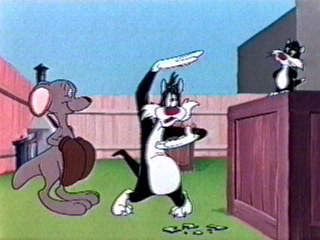
No matter how badly Sylvester gets thrashed around by Hippety Hopper, a dwarf eagle (Cat's Paw c. 1959) or a loud southern lady (Claws in the Lease c. 1963) Junior is always cheering for his pop. That's the main reason Junior must put a bag over his head every once in a while. His love and respect for his father is so great that seeing him thwarted is very traumatizing to him.
Of course, in order for Robert McKimson to be a full fledged auteur, one has to look at his entire filmography, including the cartoons he directed at the DePatie-Freleng studio. One such example is Pink Da Vinci (c. 1975). Here we have the oh so great Leonardo Da Vinci painting the Mona Lisa but with an ugly frown on her face. Leo is quite satisfied with that. However, the Pink Panther knows better. So, when Da Vinci isn't looking, Pink rubs off that ugly frown and replaces it with the famous smirk we know today. Leo's friend only manages to see this painting when Pink's smile is on it. He calls it a masterpiece and gives Leo a big hug. However, when Leo sees that it is not his frown on there, he throws a tantrum and instructs his friend to leave. When both Da Vinci and Pink go back and forth changing the mouth, things escalate until Leo lands himself in jail. It's then the Pink Panther who submits the finished Mona Lisa to the Louvre museum and gets the fame.
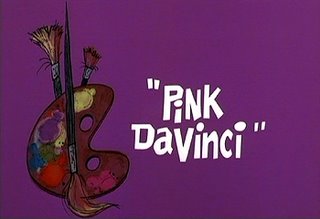



Well, that's quite a bit of examples for now. Any more and I think blogspot would burst. But, feel free to add any more observations of McKimson's binary opposites in the comments section along with any other info on McKimson like I asked before.
Nice job there, Dave. These themes that you discovered are ingenious.
ReplyDeleteThis is an interesting look on Robert McKimson.I guess Foghorn Leghorn was a vision of how he wanted but wasn't in real life.
ReplyDeleteThis is a great profile, and one that has sadly been needed for some time now. None of the books on the history of the Warner Bros. Cartoon Studio has gone to the depths that you have.
ReplyDeleteI've always admired McKimson's early work--both as animator and director; although I've been slow to appreciate his later cartoons. Your blog has helped to shed new light on the work of McKimson, and I will always keep these particular things in mind the next time I watch one of his cartoons. Great job, David! :)